How to transfer embroidery designs to fabric is one of the most frequently asked questions from beginner embroiderers and beyond.
We’re always seeking the “magic solution” for easy embroidery design transfer, and, in most cases, there is no perfect solution. Eventually, we get used to the design transfer process, and we end up with our own pet methods for transferring embroidery designs to fabric.
Now matter what transfer method we use, I think we can all agree that the notion of an iron-on transfer is pretty appealing, because it’s quick and it’s easy.
With iron-on embroidery transfers, you can be stitching complex designs in a matter of minutes, without all the hassle of tracing, pouncing, tacking – whatever design transfer method you like to use – and with no specialty tools beyond a household iron. What a deal!
The problem is finding iron-on patterns for hand embroidery that you really want to stitch. Sure, you can find playful, retro, subversive, and juvenile iron-on options out there through various companies, but it’s harder to find classy, pretty designs that are not overly faddish, with a style that will withstand the test of time a bit better.
And rarely do you find iron-on transfers and good instruction in one package.
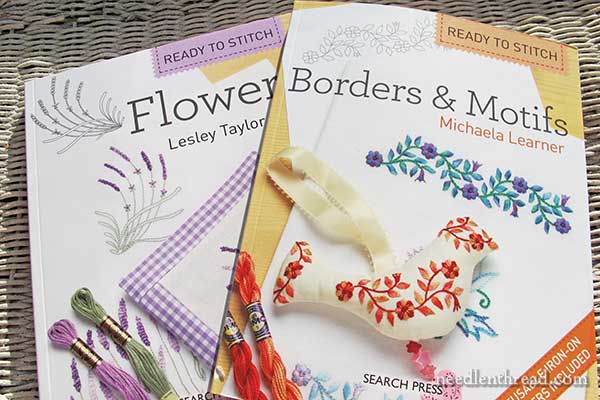
Enter: two new books on the market – Ready to Stitch: Borders & Motifs and Ready to Stitch: Flowers, published this year by Search Press.
They’re fun, they’re instructional, they’re versatile, and … they sport a nice collection of iron-on embroidery designs.
Borders & Motifs has 84 iron-on embroidery designs included in the book, and Flowers has 74 iron-on design included in it.
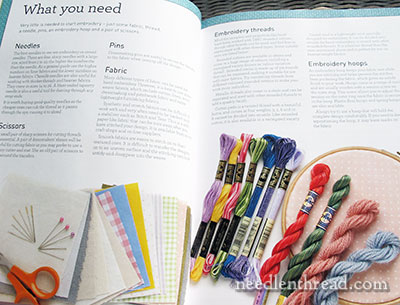
Both books start with all the basics: supplies and tools for hand embroidery, instructions on transferring designs, starting and ending threads.
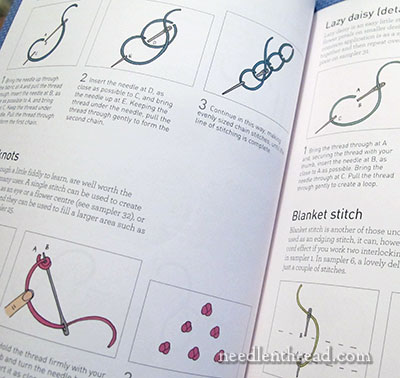
There’s also a stitch dictionary at the front of each book, with simple diagrams illustrating common embroidery stitches.
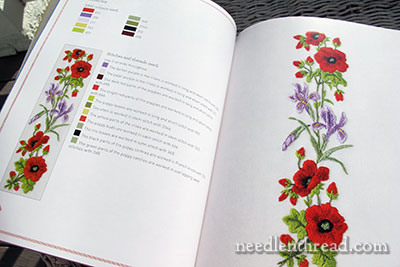
After the basics, we proceed to the “samplers” section of the books, where the designs are shown, stitched.
A color key and stitch guide accompany each design.
The design above, for example, is from Borders & Motifs, and on the right page, you can see a nice close-up of the stitched sample, and on the facing page, you’ll find all the information on DMC colors used to stitch the design, and the stitches employed in it.
Of course, you’re absolutely free to stitch the designs however you want to stitch them, but for those looking for more guidance, it’s very handy to have a color key and stitch guide available for each design!
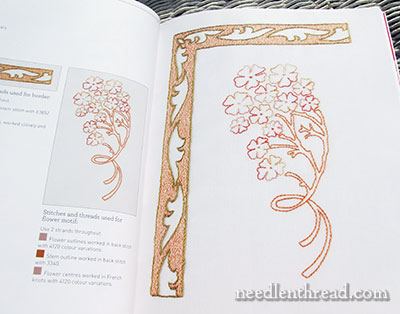
Here’s another sample from Borders & Motifs.
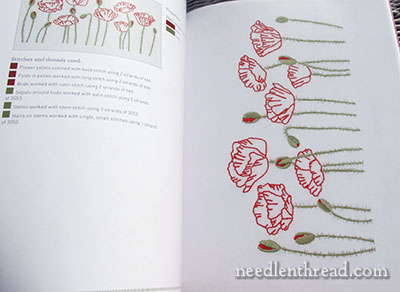
This is a design from Ready to Stitch: Flowers, showing an airy line of poppies.
Keep in mind that the stitch keys are just suggestions – you can get as creative as you want with the embroidery!
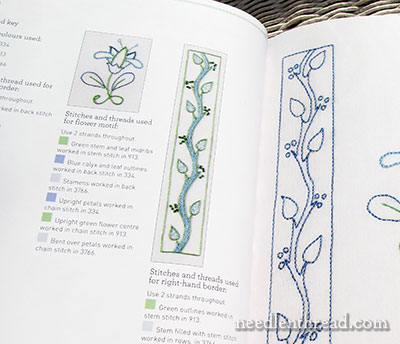
And again, another Borders & Motifs design.
Each design is not necessarily given the same coverage, page-wise – some of the designs are listed more like an index, with a clear photo, color scheme, and stitch key.
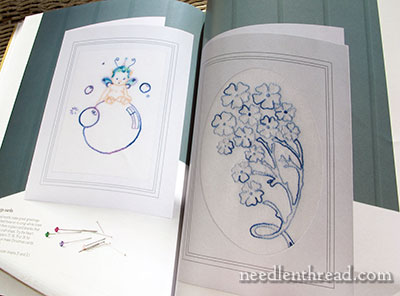
Following the “Samplers” section, you’ll find a “Projects” section in the book, where the embroidered pieces are used in specific projects, such as the greeting cards above, from Borders & Motifs.
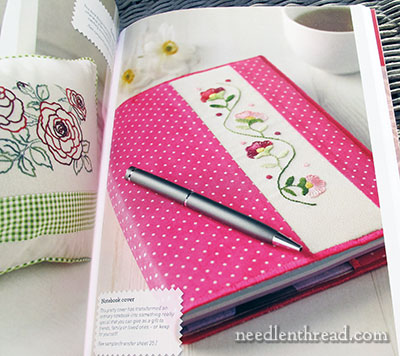
And here’s a notebook cover from Ready to Stitch: Flowers.
The “Projects” section is more of an idea and inspiration area, rather than an instructional area. You’ll find some fabulous photos of finished embroidered items that are relatively self-explanatory and easy to make, but you won’t find instructions for completing the projects.
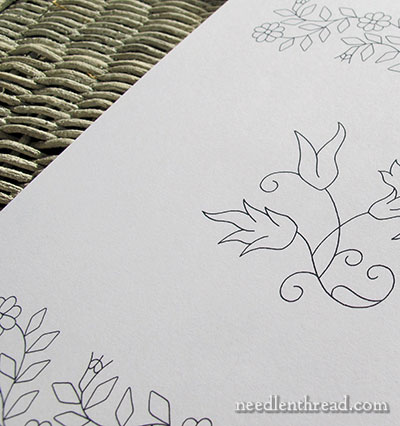
Finally, in the back of each book, you’ll find the iron-on transfer designs. They are fine-lined, which is nice! They don’t necessarily wash out of the fabric, so the design lines need to be covered.
There’s a handy-dandy pocket inside the back cover of the book for storing patterns that have been cut out and used.
Pros & Cons
The pros are numerous: pretty embroidery patterns that are easy to transfer, decent instructional diagrams for the stitches and good instructional information at the beginning of the books, plus really well done color and stitch guides, for those who want specific guidance with the embroidery. The books are very good quality, as is typical of Search Press.
Cons: Not any that I can think of, except perhaps that the books are selling like hotcakes and stock in any one place is not very high. I’m assuming that they will be restocked (they just came out a couple months ago!), but who knows? So if you’ve been seeking iron-on transfers, now’s the time to get them!
Where to find them…
You can find both books through the following book affiliates:
In the US through Amazon, you can findReady to Stitch: Flowers here and Ready to Stitch: Borders & Motifs here.
Worldwide with free shipping from Book Depository, you can find Ready to Stitch: Flowers available here and Ready to Stitch: Borders & Motifs available here.
More Iron-On Embroidery Transfer Information
You can find more reviews and information about iron-on embroidery transfers on Needle ‘n Thread:
Iron-On Embroidery Transfers from Mani di Fata
Really Nice Iron-On Transfers for Embroidery
Embroidery Iron-On Transfer Book: Fleurs en Transferts







These books look great! Thank you so much for reviewing these, Mrs. Corbet. I just added them to my Christmas list right after I read your review.
(yeah, I know, I started a Christmas list before Thanksgiving. But I won’t show it to people until after)
I do have one question: How many times can you use an iron-on transfer pattern? Is it just a use-it-once-and-throw-it-away kind of thing or can you use them multiple times?
Sarah 😀
They say up to ten times. I haven’t tried any of them ten times, but I know you can use them several times…!
That’s great! Thank you 🙂
The one time I used an iron-on more than once, I also did not know how many times I could use it. I actually scanned it (you could likely use a copier for the same thing) so that if I needed it more times, I could use a sulky iron-on pen to do it again if I needed to. I used the pattern four times before it went floopy. I had to leave the heat on the pattern longer and longer with each use though. I also expect that the number of times depends on how dark you need the pattern to be. It could be that the ten times means “barely visible”…… Just a thought. 🙂
Thanks, RMW. 🙂
Thanks Mary! These are going on my Christmas list. I love the smaller designs but also having the ability to combine them to make larger projects. I’m so glad I found your website, you are an endless treasure trove of inspiration.
I think these books are so useful for jump starting ideas. Like you said you can start with the pattern and add your own whim.
I’ve been eyeing the “Flowers” one for a while, it’s lovely!
Annnnnd more books for the want list! These look nice. I have some vintage iron-on patterns with flowers, but so often they are tattered and brittle. If not outright missing bits. And I wonder how well the inks age too. But often the commonly found vintage patterns are for kids or kitchen-cutsie (perhaps kitschen is more suitable word). I wonder if there simply weren’t that many other patterns or if there were more and those all got used up.
As far as reusing, I think the key words (just like when companies tout how fast their internet connections are) are “up to”. I imagine how long you heat and how much the fabric soaks up the ink has a lot to do with how many times it can be used?
Thanks. I am a beginner. These books are what I am looking for. Thanks for all the How to videos. They help me a lot.
Both books went on my Christmas wish list on Amazon, Mary. I’m emailing the list to my husband this week, so good timing!
Embroidery transfers like this are my “mental Doritos” for when I need to stitch to keep my hands busy but don’t necessarily need my brain engaged. And I’m generally working on a dish towel–something about anthropomorphic vegetables and dancing kitchen utensils just tickles me. But browsing through these books has given me so many ideas!
Mary, I do love your book reviews!!! These both looked so tempting that I had to go quickly to Amazon and order them. I almost hope that they run out of stock so that they have to re-order or even do another print run. GREAT for the authors and also for those of us who like to recommend our ‘best books’ to our friends or give them as gifts.
G’day Mary,
A stitch in time. Make that a post in time! I’m making a bird theme in our living / lounge area. Been wanting to make a few of the birds, just like the one in the picture of the front covers of these books, to fill a little basket, or make a garland or mobile or whatever. I like the idea of having them loose in a container of some sort so people can pick them up, feel them, connect. Or children can line them up etc, under my watchful eye!
Have a Pinterest board for ideas for a birdie room. The main thing will be an elaborate aviary type door to keep them in….just trickin’.
And, have been looking at transfer designs lately, to now avail, although the retro in me finds them charming in a way. These are ideal.
Bought, settled, sealed and done.
Thank you. Cheers, Kath.
Must.Not.Add.To.Stash. I still have some of my grandmothers’ (plural, both sides of family) iron-on transfers from the earliest days such transfers were sold. But these look so tempting …
I recently took an embroidery class, and we used Transfer Eze to transfer the design. Basically, you run it through your ink jet (NOT laser jet) copier and then stick it to your fabric, sew and then rinse. The transfer paper and all marks come out very well. I was concerned about it leaving residue, but it didn’t on mine. I was quite pleased and would use it again. You can copy anything you want to sew. 🙂
thanks so much Mary for the review — I just added both to my Amazon cart. They both look great and just what I have been looking for !
I may be mistaken, but can´t you make your own iron-on-transfer-patterns? I know there is the paper you use and you can draw on it with a pen that transfers to the fabric… at least I am pretty sure that I have seen something like that… It does not wash out, but it sounds very easy and practical.
Thoughtful wishes,
Marion
I used one of those transfer pens for regular paper about 20 years go. It worked well but the drawback was the lines were much thicker than what’s on purchased transfers. It wasn’t an issue with what I was doing (painting the design on fabric) but it would be if you wanted a more delicate embroidered design. There may be pens that are finer tipped now.
I was lucky enough to have won a giveaway of the Ready to Stitch Flowers book. I have not had time to begin using it yet, but it is a lovely book. I really want to embroider many of the flowers. (And I have not embroidered this type of thing in over 30 years.)
Thank you Mary. Once again you have introduced two great books. I’ve looked high and low for a beautiful iron on design book. So, as I often do with my second cup of coffee, I clicked onto your web page and low and behold an early
Christmas present for me.I have already ordered them from Amazon.
I know I speak for many, your contributions to the embroidery world is very much appreciated.
Barbara Boston
One possible con –
If one makes items for sale or even for donation where the purpose is for them to be sold (church bazaar, etc.) one has to check for the copyright of the book and see what is allowed.
Dear Mary and anyone interested in the Borders and Motifs book: Homesew has it! They had it listed in the latest catalog they mailed to my home this past week. It’s under $25.
A Happy and Blessed Thanksgiving to all!
DHH
I’m looking for iron on Beatrix Potter transfers. Any help you can provide is appreciated. thx